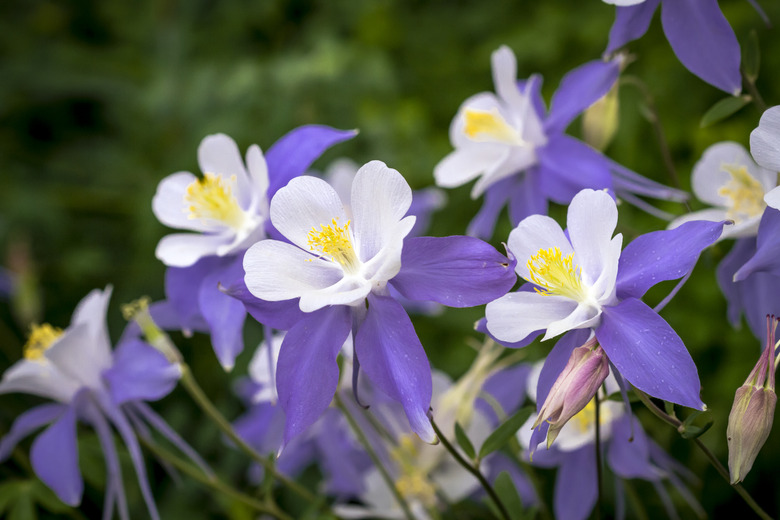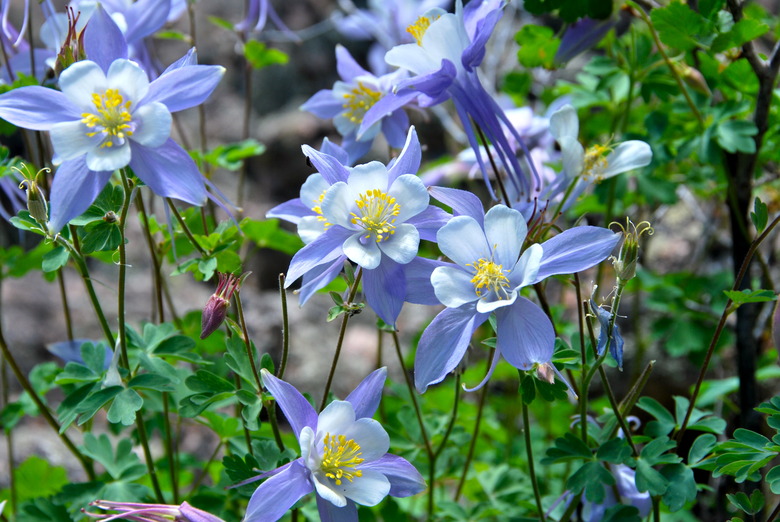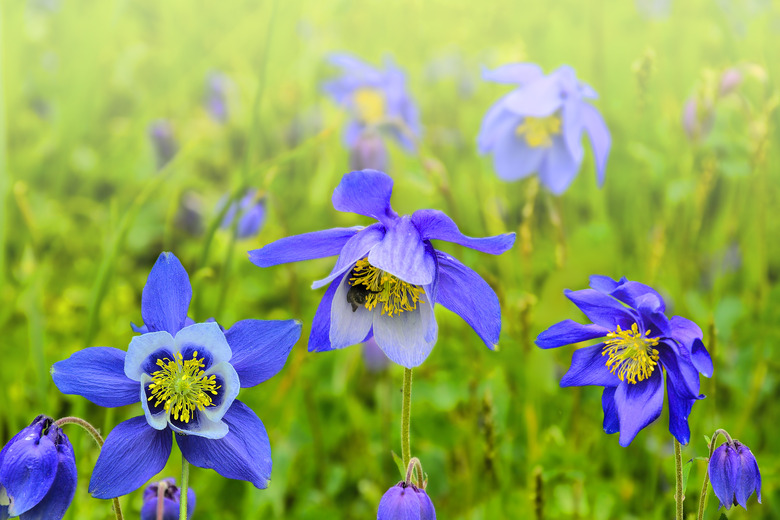How To Grow Columbine Flowers
We may receive a commission on purchases made from links.
- Best uses for columbine
- How to grow columbine
- Starting columbine from seed
- In what zone does columbine grow best?
- When should you plant columbine?
- Soil, sunlight and water recommendations for columbine
- How to propagate columbine
- How to winterize columbine
- Common pests and other problems for columbine
- Common diseases for columbine
Columbine (Aquilegia spp.) is a beautiful biennial or perennial plant that is surprisingly rugged and low maintenance. The plants grow in clumps, and depending on the species, they can grow from 6 inches to 3 feet tall and 18 inches wide with lacy, bluish-green foliage. Often (but not always), the bicolor flowers bloom in spring, early summer and/or fall and come in a wide variety of shades, including pinks, blues, purples, whites, yellows, reds and oranges, with some cultivars even blooming in multiple color combinations on the same bush. While the spurred flowers may look delicate, these plants are wonderfully hardy and are not only drought tolerant when established but will also often survive the first frosts of winter before going dormant.
Best Uses for Columbine
Best Uses for Columbine
Columbine, also called "granny's bonnet" or "crowfoot," is a hardy plant that survives well in the wild and is easy to grow in the flower garden, along pathways or in planters. In fact, they like a little shade, making them a great companion to taller plants. Columbine specifically does well with alliums, foxgloves, heucheras, irises, daylilies, peonies, alliums, phloxes and poppies.
While columbine only lives two to three years, it is a prolific self-sower, so once established, you can expect to see new blooms year after year. Unlike many other plants that self-sow, the new seedlings usually do not get out of hand, and the plants can be easily pulled if they grow where they are unwanted.
How to Grow Columbine
How to Grow Columbine
- Common Name: Columbine
- Botanical Name: Aquilegia spp.
- When to Plant: Spring or
late fall - USDA Zones: 3-9, depending on species and cultivar
- Sun Exposure: Full sun or
light shade - Soil Type: Well-draining
with a neutral pH - When it's in Trouble: Tunnel-like damage in the foliage, white powder on the underside of
the leaves - When it's Thriving: Lacy foliage, delicate-looking flowers
Starting Columbine From Seed
Starting Columbine From
Seed
In the wild, columbine seeds usually sit dormant in the winter before they germinate, and this process is best replicated by stratifying the seeds by storing them in your refrigerator for three to four weeks before sowing them. This will help simulate germination, as it mimics the flower's natural growing conditions. Once stratified, seeds can be planted in containers in your home or straight into prepared garden beds.
To grow seeds indoors, start them six to eight weeks before the last expected frost date. To grow them outside, you'll want to sow seeds after the last spring frost. Alternatively, your stratified seeds can be sown in early fall (around September) as long as they have enough time to become established before the first frost; they will bloom for the first time in the following year. You can even sow seeds that haven't been stratified in late fall and allow the cool weather to naturally put the seeds in a dormant period until they are ready to germinate in early spring.
If you start seeds indoors, sow them in moist planting soil in seed trays or pots by gently pressing them into the soil and leaving them uncovered by the soil. Place the pots in a warm place with indirect sunlight for 30 days or so until they germinate. When they are a few inches tall and have their first real leaves, the seedlings will be ready to be transplanted, although you should first harden them off to reduce the risk of transplant shock.
To harden off seedlings, move them outdoors during the day, ideally when it is between 65 and 70 degrees Fahrenheit with six hours of morning sun. Make sure the pots are protected from wind and hot afternoon sun and bring them inside if there is any possibility of frost. After a week, they should be ready to transplant.
To transplant into a new container or into outdoor soil, dig a hole twice as wide as the diameter of the current pot. Set the plant in the soil with the top of its root ball level to the surface of the soil and then gently add soil to fill in the rest of the hole.
If you want to seed directly into outdoor gardens, prepare the garden soil by incorporating organic matter, such as compost or leaf mulch, with the top 6 inches of your native soil to improve drainage. Gently press the seeds into the soil and leave them uncovered.
At all stages of planting, always ensure your soil is kept moist but not soaked. Mulching can help ensure even moisture. Fertilize with a starter mix three to four weeks after planting. When the plants are nearly mature, thin out all but the strongest plants to provide 1 to 2 feet of space between the plants depending on the variety. If the plants overgrow their location before midsummer, prune them back to encourage more blooms.
In What Zone Does Columbine Grow Best?
In What Zone Does Columbine Grow
Best?
Columbine is hardy enough to survive in most of the continental United States, doing just fine in zones 3 through 9, depending on species and cultivar. That being said, it's always best to check the specific zone recommendations for a particular variety before planting if you live on either end of the hardiness spectrum.
The bloom cycle will vary based on climate. Generally, deadheading the flowers and removing any browned foliage after each bloom will help encourage further growth to continue throughout the summer. If you live in a hot climate or if the plant gets a lot of sun even in a temperate climate, the hot weather may cause the plant to go dormant by summer, and it will wait until fall to start growing and blooming again. In warm areas, continue to deadhead flowers and prune back unhealthy foliage, but don't be surprised when the plants wait until fall to start growing again.
When Should You Plant Columbine?
When Should You Plant Columbine?
Generally, the best time to sow columbine seeds is in spring. You can also wait until early fall to plant seeds that were stratified over the summer, which will allow the plant to become established just before the first frost.
All of these methods require stratifying seeds in the refrigerator. If you prefer not to stratify seeds yourself, then let nature do your work for you by sowing the seeds just before the first frost. This way, your plants will sprout in early spring just like wild columbine.
Soil, Sunlight and Water Recommendations for Columbine
Soil, Sunlight and Water
Recommendations for Columbine
Columbine likes soil with a neutral pH and ample organic matter, but the most important factor is that it is well-draining and stays moist. While these flowers are generally not very particular about their growing conditions, they don't do well with heavy clay soils and instead prefer sandy or loamy soils. Although not necessarily a problem, it's worth noting that columbine plants grown in particularly rich soils sometimes grow tall enough that they need to be staked, or they may fall over. Whatever soil you use, mulch with a thick layer of compost or manure to help maintain moisture levels and fertilize the soil.
While the plant can do well in most areas, let your climate guide you when it comes to planting location. In hotter climates, it's better to grow in an area with dappled shade to protect the leaves from getting scorched in the hot afternoon sun. On the other hand, columbine is much happier in full sun when grown in cooler climates, which will increase the number of blooms.
While constant moisture is critical for proper germination and early growth, the plants are actually fairly drought tolerant once established. For best results, once the plants have become established, water just once a week if there has been no rainfall. If you want your flowers to self-sow, then maintain constant moisture during early spring when seeds are most likely to naturally germinate.
How to Propagate Columbine
How to Propagate Columbine
Though columbine will only live two or three years, most people who grow it will be able to keep their garden full of the plant year after year because it is such an effective self-sower. It's always a good idea to deadhead columbine flowers during the spring and early summer to extend the growing season by as much as six weeks by cutting off faded flowers before they go to seed.
To grow more flowers, be sure you allow the last round of flowers to remain on the plant to allow for self-sowing. That being said, if you have planted more than one variety, expect the offspring of your plants to look different than the ones you originally planted, as they cross-pollinate quite easily.
If you'd like to grow columbine in a new area, you can also try root division, although the deep roots are fragile, and the plants often do not survive the process. For best results, wait until spring to dig a circle as deep as possible around the roots. Gently lift the dirt clump, set it on the ground and try not to break up the soil. Then, use a sharp spade to divide the roots while leaving as much soil as possible around the roots. Replant both sections as quickly and gently as possible and be sure to keep them watered until they have become well established once more.
How to Winterize Columbine
How to Winterize Columbine
Winterizing columbine is easy enough and essentially involves cutting off and disposing of all the foliage. If you want the plants to self-seed, be sure the seeds have fallen from the flower heads before cutting back the plants. Add a thick layer of mulch around the plants to protect the roots during the winter and be sure to continue watering until the first frost hits.
Common Pests and Other Problems for Columbine
Common Pests and Other Problems
for Columbine
Columbine is not only low maintenance but it's also fairly pest-resistant. You do need to look out for leaf miners, though. These brown and black flies lay eggs on the underside of columbine leaves so their larvae can eat through the plant foliage. This will cause ugly, tunnel-like damage to the plants, but it is purely cosmetic and will not do any actual harm.
To take care of leaf miners, remove the eggs by hand when you see them. If they continue to be a problem, trim off affected foliage and throw it away. For severe infestations, apply neem oil.
Common Diseases for Columbine
Common Diseases for Columbine
Just as columbine is resistant to most pests, it also is susceptible to very few diseases. Powdery mildew can be an issue, though. This fungal disease results in a dusty white coating, and unlike leaf miners, this can actually damage your plant, stunting its growth or even killing it entirely.
To prevent this problem before it starts, be sure to provide your plants with adequate space to allow for sufficient airflow, do not overwater the plants and leave 2 inches of space around the stems when mulching. If you notice powdery mildew, apply neem oil.


